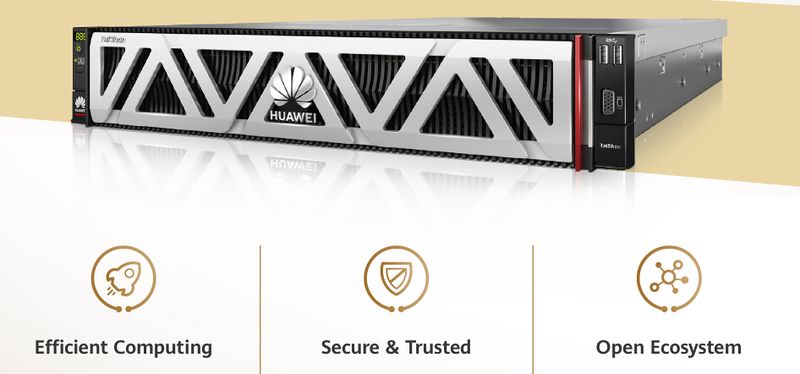Amazon Is Following Chinas Lead Towards a ARM Based Cloud Future
The American Cloud provider Amazon AWS announced the availability of instances powered by a their second-generation in-house ARM processors Graviton2 this week. Their new 64-bit ARM chips are made on TSMC's 7nm process and they promise faster performance at lower latency. Instances with 1-64 vCPUs and up to 512 GB RAM will become available.
written by 林慧 (Wai Lin) 2019-12-07 - last edited 2019-12-07. © CC BY

"Cloud" is just a marketing term for CPU-time on someone else's server somewhere. The artwork in this picture, taken in Norway's capital Oslo in 2006, has absolutely nothing to do with this story.
Amazon launched cloud instances with their first generation ARM-based Graviton chips back in November 2018. Their story then was that their in-house chips's advantage was "a significantly lower cost". The new Graviton2 instances are, in contrast, described by Amazon in their press-release titled "Coming Soon – Graviton2-Powered General Purpose, Compute-Optimized, & Memory-Optimized EC2 Instances as chips with a performance-advantages over their regular cloud instances:
"It is based on 64-bit Arm Neoverse cores, and can deliver up to 7x the performance of the A1 instances, including twice the floating point performance. Additional memory channels and double-sized per-core caches speed memory access by up to 5x."
December 3rd, 2019
Amazon goes on to list the following performance advantages over their existing "M5" cloud instances:
- HTTPS load balancing with Nginx: +24%
- Memcached: +43% performance, at lower latency
- X.264 video encoding: +26%
- EDA simulation with Cadence Xcellium: +54%
These are Amazon's claims. There is no way to verify if they hold water.
Amazon did not list any concrete specifications like memory support, clock speeds, TDPs or anything like that in their announcement. These chips are meant to be rented out to cloud customers, not sold, so they have no need to reveal those details.
Graviton2 Changes The Playing-field[edit]
The first generation Graviton chips were on-par with Intel's embedded offerings. It's performance wasn't all that. It was cheap and that was it' The Graviton2 chips are alternatives to Intel's high-end Xeon server chips. That's new and it is a big deal.
Amazon AWS has been one of chip giant Intels larger customers for a very long time. Intel has been delivering custom SKUs at large volume discounts. Amazon has, so far, appeared to be happy with this relationship. Perhaps they were secretly disappointed with Intel's lack of progress on the CPU side. Perhaps they simply decided to develop high-performing ARM chips because they could. The end-result is the same: Amazon AWS is now far less reliant on Intel than they were.
AWS can now use their own hardware to offer instances with vCPUs rivaling CPUs on bare-metal servers powered by both Intel's Xeon chpis and AMD EPYC chips. That is a big deal and it very bad both Intel and AMD and it is especially bad for Intel.
Following China's Lead[edit]

A ARM-based TaiShan server from Huawei.
The Chinese telecommunications giant Huawei has been shipping it's "TaiShan" servers with Huawei's very powerful 64-bit ARM Kunpeng chips to large Chinese data centers and cloud providers like Alibaba since mid-2019. The Kunpeng line's flagship, the 920-6426, has 64 cores running at 2.6 GHz with a TDP of only 180W. Those chips have PCIe 4.0, 100G Ethernet and CCIX connectivity. Their high-end TaiShan servers have dual-socket boards with two 64-core Kunpeng 920-6426 ARM chips running at up 2.6 GHz.
The Americans voluntarily decided to deny themselves access to these superior Chinese chips shortly after their president Trump was selected. They made that foolish decision to protect their domestic-based corporations. Amazon is now finally catching to the Chinese up with their new Graviton2 ARM chips. Other American corporations will likely follow suit.
Intel Can Still Rely On The Desktop Market[edit]
The game's not over for the American chip giant Intel who currently dominates the desktop and laptop computer markets with a marketshare of 80% (AMD being second with the remaining 20%). The server-space is largely dominated by Linux-based operating systems. Windows still rules the desktop and laptop computers most end-users interact with. Linux is present in that market as well but the total combined marketshare of all GNU/Linux distributions is less than 1%. The Windows operating system is dominated by closed-source locked-down proprietary software. You can easily re-compile common server software to run on another architecture. It is not so when it comes to the vast majority of desktop software; Windows running on a x86-64 CPU is required to run the vast majority of software which is commonly used today.
GNU/Linux users are the only ones who will be able to take advantage of the few powerful ARM-based desktop offerings such as Huawei's Kunpeng Desktop Board. It is a single-socket Kunpeng consumer-style motherboard with 6 SATA ports, 2 M.2 SSD slots, 4 DDR4 RAM slots (64 GB max). The American government will never let their citizens have access to this but it could be made available to Europeans through their local retailers. If this will happen or not is unclear; They do not support the Windows operating system and the GNU/Linux desktop marketshare is very low.
ARM has been dominating the smartphone and tablet markets for a long time. It seems clear that ARM chips are in the process of taking over the server space. The American chip makers Intel and AMD should be very worried. They have the desktop and laptop markets - for now. Microsoft, who makes the Windows operating system and also happen to be an American company, could change that in a heart-beat.


Enable comment auto-refresher